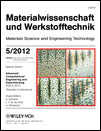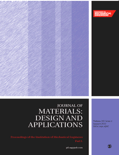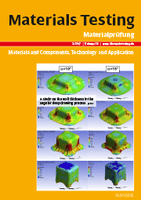
MATERIALWISSENSCHAFT UND WERKSTOFFTECHNIK
Scope & Guideline
Transforming Ideas into Material Solutions.
Introduction
Aims and Scopes
- Material Characterization:
The journal extensively covers the characterization of materials, focusing on their mechanical, thermal, and chemical properties. This includes studies on microstructure, wear resistance, corrosion behavior, and fatigue performance. - Composite Materials:
A significant portion of the journal's publications addresses composite materials, including metal matrix composites, polymer composites, and hybrid materials. These studies often explore the reinforcement of base materials with nanoparticles or other additives to enhance performance. - Processing Techniques:
The journal publishes research on various processing techniques such as additive manufacturing, friction stir welding, and advanced casting methods. These studies emphasize optimizing process parameters to improve material properties and production efficiency. - Sustainable and Biocompatible Materials:
Recent trends in the journal highlight the development of sustainable materials, including biocomposites and eco-friendly processing methods, addressing environmental concerns in material production and application. - Computational Modeling and Simulation:
The journal also emphasizes the role of computational methods in materials science, including finite element analysis and machine learning approaches for predicting material behavior and optimizing processing techniques.
Trending and Emerging
- Nanomaterials and Nanocomposites:
There is a growing interest in nanomaterials and their application in composites to enhance mechanical and thermal properties. Research focuses on integrating nanoparticles into traditional materials to develop advanced composites with superior performance. - Additive Manufacturing Innovations:
The journal has increasingly published studies on additive manufacturing techniques, particularly in optimizing parameters for 3D printing applications. This trend reflects the industry's shift towards more customized and efficient manufacturing processes. - Smart Materials and Structures:
Research into smart materials that respond to environmental stimuli is gaining momentum. This includes shape memory alloys and materials with self-healing properties, which are becoming more relevant in various engineering applications. - Recycling and Sustainable Practices:
Emerging themes in sustainability highlight the recycling of materials and the development of eco-friendly processes. Research focusing on the utilization of waste materials, such as fly ash or agricultural waste, in composite production is increasingly prominent. - Machine Learning Applications in Materials Science:
The application of machine learning techniques in predicting material properties and optimizing processing parameters is on the rise. This trend indicates a shift towards data-driven approaches in materials research, enhancing predictive capabilities and efficiency.
Declining or Waning
- Traditional Metallurgy:
There has been a noticeable decrease in publications focusing solely on traditional metallurgy techniques that do not incorporate modern materials processing or innovations. The shift towards advanced materials and processing methods has overshadowed conventional approaches. - Non-structural Applications:
Research focusing on non-structural applications of materials, such as aesthetic or decorative uses, has diminished. The journal's recent emphasis has shifted towards structural and functional applications that address performance and sustainability. - Basic Materials Science:
The exploration of fundamental materials science principles, without application to specific technologies or industries, appears to be less frequent. The journal's audience seems to favor applied research with clear industrial relevance.
Similar Journals

TRANSACTIONS OF THE INDIAN INSTITUTE OF METALS
Unveiling new horizons in metal science.TRANSACTIONS OF THE INDIAN INSTITUTE OF METALS is a premier journal published by Springer India, dedicated to the field of metallurgy and materials science. Established in 1969, this journal serves as a vital platform for researchers and professionals to disseminate their findings on metals and alloys, showcasing innovative studies and experimental techniques. With an impressive impact factor and categorized in the Q2 quartile for metals and alloys as of 2023, it ranks 70 out of 176 in its field according to Scopus, placing it in the 60th percentile. The journal maintains a robust reputation for fostering academic excellence, thus attracting contributions from both established and emerging scholars. Though not an open access publication, its well-curated content remains a crucial resource for advancing knowledge and technology in metallurgy. The journal's extensive operational history, particularly during notable converged years, underscores its enduring significance in the scientific community.

JOURNAL OF CERAMIC PROCESSING RESEARCH
Transforming Ideas into Advanced Ceramic SolutionsJOURNAL OF CERAMIC PROCESSING RESEARCH, published by the Korean Association for Crystal Growth, Inc., serves as a vital source of scholarly communication in the field of ceramics and composites. With an ISSN of 1229-9162, this well-regarded journal aims to advance knowledge through rigorous research and publication of innovative studies that push the boundaries of ceramic processing technologies. Indexed in Scopus and boasting a 2023 Q3 ranking in the ceramics category, it provides a platform for researchers to disseminate their findings and engage with emerging trends in material science. The journal reflects a commitment to contributing to the scientific community, emphasizing the importance of interdisciplinary collaboration and advancements in fabrication techniques. Although it operates under a traditional access model, the journal is a beacon for researchers, professionals, and students, inviting them to explore breakthroughs from the years 2000 through 2024 and beyond.

JOURNAL OF MATERIALS PROCESSING TECHNOLOGY
Driving Progress in Cutting-Edge Materials ResearchJOURNAL OF MATERIALS PROCESSING TECHNOLOGY, published by ELSEVIER SCIENCE SA, is a premier international journal dedicated to the dissemination of cutting-edge research in the field of materials processing. With an impact factor indicative of its high academic quality, this journal features a diverse range of topics, including ceramics, composites, metals, and manufacturing technologies, thereby inspiring innovations within its community. As a recognized Q1 journal across multiple categories—including Ceramics and Composites, Computer Science Applications, Industrial and Manufacturing Engineering, and Modeling and Simulation— it ranks among the top in its field. The journal's rigorous peer-review process ensures the publication of only the most significant and relevant studies, supporting researchers, professionals, and students in advancing their knowledge and expertise. With its commitment to excellence, the JOURNAL OF MATERIALS PROCESSING TECHNOLOGY remains a vital resource for those aiming to push the boundaries of materials science and engineering.

Advances in Materials Science
Transforming Ideas into Cutting-edge ApplicationsAdvances in Materials Science, published by SCIENDO, is a pivotal journal in the field of materials science that focuses on the latest developments and breakthroughs in the study and application of innovative materials. With a commitment to advancing knowledge across various sub-disciplines, this journal provides a platform for researchers, professionals, and students to share their findings, explore new methodologies, and discuss the implications of materials science on technology and industry. The journal, indexed under the ISSN 2083-4799 and E-ISSN 2083-4799, promotes open dissemination of research, encouraging a collaborative approach to problem-solving across disciplines. Its emphasis on high-quality, peer-reviewed articles positions it as an influential resource within the academic community, driving forward the boundaries of what is possible in materials science. Advances in Materials Science continues to be an essential read for anyone dedicated to understanding and innovating in the materials domain.

RARE METAL MATERIALS AND ENGINEERING
Shaping the Future of Metallurgy and EngineeringRARE METAL MATERIALS AND ENGINEERING is a vital academic journal dedicated to advancing the fields of materials science, engineering, and metallurgy. Published by the NORTHWEST INST NONFERROUS METAL RESEARCH in China, this journal has been an essential resource for researchers and professionals since its inception in 1993. With a focus on rare metals and their engineering applications, the journal addresses contemporary issues and innovations in materials chemistry and electronic engineering, providing insights into the properties and uses of advanced materials. Although it currently falls within the Q4 category for several categories, including Electrical and Electronic Engineering and Materials Chemistry, its commitment to quality and relevance in the field is evident. The journal offers a platform for researchers to share their findings with the scientific community, fostering collaboration and knowledge exchange in an important area of study. Researchers and students interested in exploring the latest in rare metal technologies and engineering methodologies will find this journal a valuable addition to their academic library.

JOURNAL OF THE MECHANICAL BEHAVIOR OF MATERIALS
Connecting Theory and Application in Material BehaviorJOURNAL OF THE MECHANICAL BEHAVIOR OF MATERIALS, published by DE GRUYTER POLAND SP Z O O, is a prominent open-access journal in the field of materials science and mechanics, dedicated to facilitating the dissemination of high-quality research findings since 2019. With an ISSN of 0334-8938 and an E-ISSN of 2191-0243, this journal provides a platform for researchers, professionals, and students to explore the mechanical behaviors of various materials, crucial for advancing engineering and scientific applications. The journal's impact is evidenced by its impressive rankings, including Q2 status in both Materials Science (miscellaneous) and Mechanics of Materials as of 2023. With a Scopus rank placing it in the top-half of indexed journals, the JOURNAL OF THE MECHANICAL BEHAVIOR OF MATERIALS is a vital resource for anyone looking to stay at the forefront of material behavior research. Based in Germany, it serves the global academic community while catering to the evolving needs of industry practitioners through its comprehensive open-access model.

PROCEEDINGS OF THE INSTITUTION OF MECHANICAL ENGINEERS PART L-JOURNAL OF MATERIALS-DESIGN AND APPLICATIONS
Exploring the Intersection of Mechanical Engineering and Material SciencePROCEEDINGS OF THE INSTITUTION OF MECHANICAL ENGINEERS PART L-JOURNAL OF MATERIALS-DESIGN AND APPLICATIONS is a prestigious academic journal published by SAGE PUBLICATIONS LTD, focusing on the dynamic fields of mechanical engineering and materials science. With an impressive impact factor reflective of its rigorous scholarly contributions, this journal serves as a vital platform for the dissemination of innovative research and practical applications in materials design and engineering processes. Since its inception in 1999 and continuing through 2024, it has maintained a robust reputation, achieving a Q2 ranking in both Materials Science (miscellaneous) and Mechanical Engineering categories, as well as commendable Scopus ranks that place it in the top percentiles of its fields. Located in the United Kingdom, the journal encourages submissions from researchers and professionals who are seeking to advance their understanding of materials applications while fostering interdisciplinary collaboration. Although it currently operates under traditional access terms, the journal prioritizes impactful research that addresses contemporary challenges in design and manufacturing, ensuring that it remains a must-read for anyone invested in the innovations shaping our technological landscape.

PHYSICS OF METALS AND METALLOGRAPHY
Decoding the Complexities of Metal Structure and BehaviorPhysics of Metals and Metallography, published by MAIK Nauka/Interperiodica/Springer, is a respected journal dedicated to the study of the physical properties of metals and their metallographic analysis, offering invaluable insights for researchers, professionals, and students in the fields of condensed matter physics and materials chemistry. With an ISSN of 0031-918X and an E-ISSN of 1555-6190, the journal has a rich history that spans from 1970 to 2024, reflecting a long-standing commitment to advancing knowledge in this vital area of materials science. Although it currently does not offer Open Access options, its strong placement in the academic landscape is underscored by its Q3 ranking in both Condensed Matter Physics and Materials Chemistry, according to 2023 metrics, and a Scopus ranking that places it within the competitive percentile of its fields. The journal is particularly important for those engaged in the cutting-edge research and technological applications of metals and alloys, making it an essential resource for anyone looking to deepen their understanding or contribute original findings to this dynamic discipline.

Materials Testing
Empowering Research in Mechanics of MaterialsMaterials Testing is a renowned journal published by Walter de Gruyter GmbH, serving the global scientific community in the fields of Materials Science, Mechanical Engineering, and Mechanics of Materials. With an ISSN of 0025-5300 and an E-ISSN of 2195-8572, this journal has been a significant contributor to the discourse on material performance, testing methodologies, and engineering innovations since its inception. The journal is recognized for its rigorous peer-review process and holds a commendable Q2 quartile ranking in multiple categories for 2023, showcasing its impact and relevance in the field. With open access options available, Materials Testing aims to disseminate valuable research findings and practical insights that drive advancements in technology and materials applications. By addressing the latest challenges and developments within the field, this publication serves as an essential resource for researchers, professionals, and students alike, fostering a deeper understanding of material properties and testing techniques.

Materials Physics and Mechanics
Unraveling the Complexities of Condensed MatterMaterials Physics and Mechanics is a pivotal journal dedicated to advancing the fields of condensed matter physics, materials science, mechanical engineering, and the mechanics of materials. Published by the Institute of Problems in Mechanical Engineering, Russian Academy of Sciences, this journal has established itself as a valuable resource since its inception, particularly from 2003 to 2004 and now continuously from 2009 to 2024. Although it currently holds a Q4 categorization in various disciplines, its contributions are critical to understanding and developing new materials and their applications in engineering. The journal provides insightful articles that explore the nuances of material properties, their behaviors under different conditions, and the physical principles governing these phenomena. Though it operates under a traditional publication model, the insights provided within its pages are invaluable to researchers, professionals, and students striving to push the boundaries of knowledge in the materials domain. Its ISSN numbers (1605-2730, E-ISSN 1605-8119) serve as a gateway to a wealth of scientific knowledge emanating from the Russian Federation, contributing to the global discourse in materials physics and mechanics.